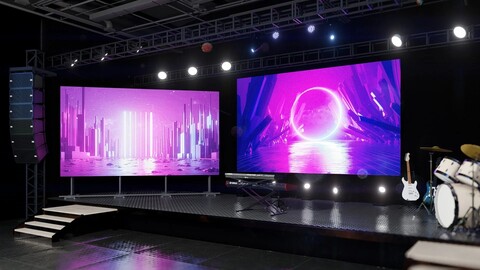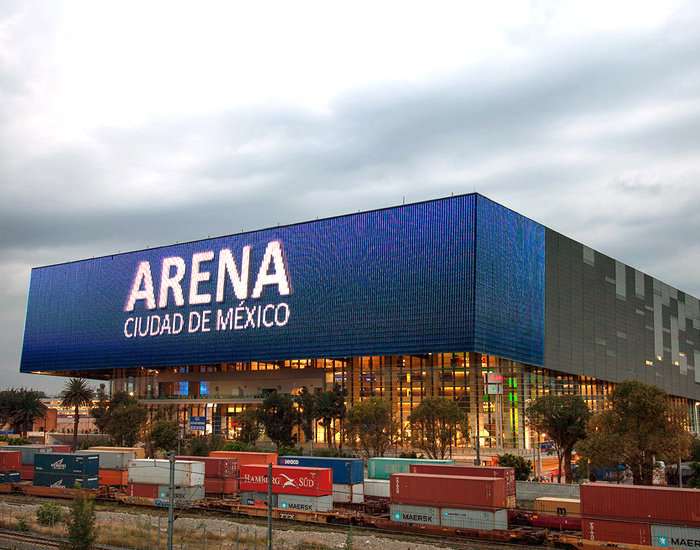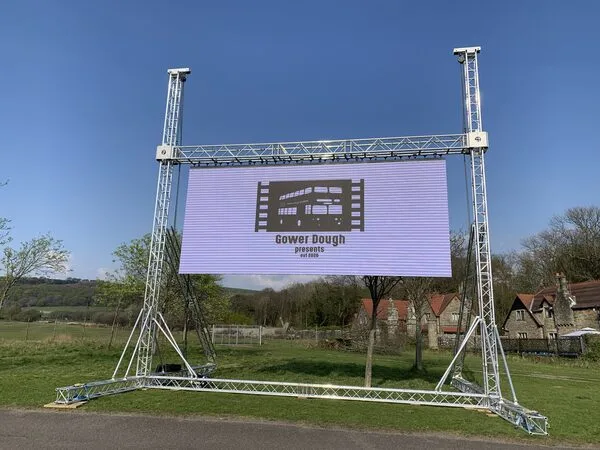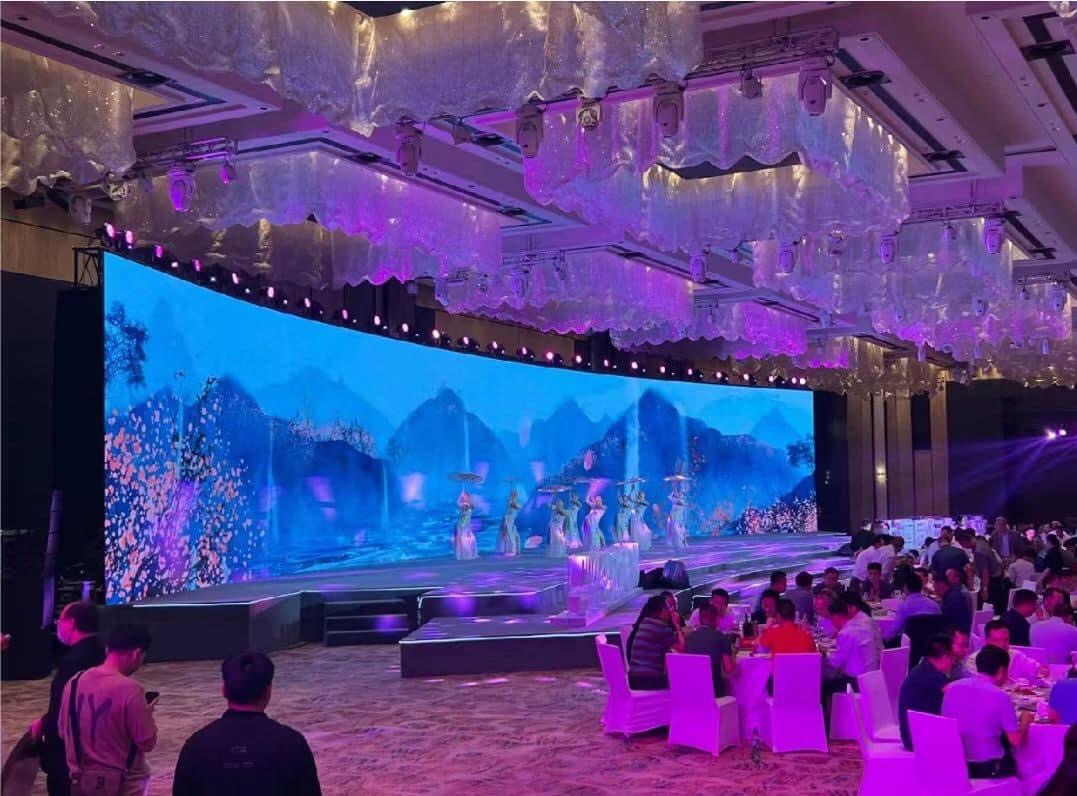
LED video wall panels suitable for indoor and outdoor use
Imagine the excitement you get while watching the trailer of the latest Fantastic Four movie on a large LED screen panel display hung by the roadside as you stroll the streets. This is the allure that LED video wall panels provide, and it explains just why they have become an essential in today’s modern landscape. From delivering clear, captivating and brilliant visuals to offering enhanced brightness levels and better durability than LCD displays, these gadgets are a truly worthwhile investment for an organization.
1.LED video wall panels: A Modern Display Solution
LED video wall panels essentially make use of light-emitting diode technology to display eye-catching visuals. They are widely used for advertising and marketing purposes in addition to other functions in sports venues and also in the corporate world for business meetings.
1.1 Why are LED video wall panels so important to you?
One of the most significant benefits of LED wall panels is their flexibility. They can be set up in virtually any kind of dimension or form, from portable indoor LED screen wall in stores to gigantic outside LED panels on arena facades. This versatility makes it feasible for companies and event coordinators to set up remarkable display screens that accommodate their unique spatial and branding demands.
On top of that, modern-day LED video wall panels supply high-resolution visuals, guaranteeing smooth playback of HD and 4K videos. Their use of energy-efficient consumption also makes them a beneficial financial investment for companies seeking to take full advantage of aesthetic impact without blowing up operational expenses.
Whether it’s a digital signboard along a busy highway, a scoreboard in a sports arena, or a background for an online program, LED video wall panels supply an innovative aesthetic charm that standard display technologies cannot match. As we enter an age defined by immersive aesthetic displays, these panels are no longer simply an alternative but a must for brands and venues intending to remain relevant.

1.2.Types of LED video wall panels
Indoor Fixed LED walls
Indoor fixed display walls are built for close viewing and high resolution. These LED walls make use of fine pixel pitches and slim cabinets to provide brilliant imagery in retail rooms, studios, exhibition spaces, and control rooms.
Pixel pitch, calculated in millimetres, influences quality, and standard indoor ranges run from about 0.9 to 4 millimetres. Front-service layout and modular cabinets simplify maintenance and maintain color uniformity across enormous walls.
Outdoor Fixed LED Panels
Outdoor panels are developed for daylight exposure and tough conditions. Outdoor LED panels offer increased brightness levels, secured cabinets, and sturdy frames so they remain vivid at long distances and in extreme weather conditions.
These displays exchange the ultra-fine pixel density of indoor walls in favor of durability and outdoor performance. Their brightness often reaches up to thousands of nits, which helps maximize visibility regardless of the weather conditions. These panels are mostly found on facades of huge buildings, billboards, stadiums and public areas.
Rental and Staging LED Panels
Rental or event panels are modular, lightweight, and optimised for rapid assembly and teardown. These LED video wall panels are utilized in shows, festivals, and temporary promotional activities.
This is because they can be assembled, curved, or modified to match stage needs. Rental modules prioritize quick rigging and durability so teams can assemble large screen panels in minimal time. Many rental options include IP-rated versions for outdoor gigs to protect electronics from rain and dust.
Transparent and Flexible LED Panels
Transparent and flexible modules unlock creative installations such as glass storefront displays and curved video walls. Transparent LED panels allow for natural light to pass through while vividly displaying motion content.
This makes them an excellent option for retail windows and architectural facades where sightlines are important. Modifiable panels bend around columns or adapt to unusual shapes, providing creative designers more liberty to combine physical and digital experiences in visually appealing ways.

Big LED walls and Jumbotrons
Large wall systems, often called jumbotrons, are engineered to serve stadiums, large outdoor advertising installations, and civic event screens. These solutions prioritise size, brightness, and structural robustness. Vendors specify high refresh rates and weatherproofing so motion stays smooth and colour remains stable on massive installations.
Choosing the right panel type means balancing resolution, viewing distance, environment, and budget, so brief your supplier with where the screen will be seen and what content you will run to get the best value.
2.How Much Do LED video wall panels Cost?
Several factors drive LED video wall panels prices, including pixel pitch and resolution, LED type and chip quality, screen brightness (nits), cabinet materials and IP rating, the control system and media server, mounting or structural work, shipping and taxes, and service or warranty packages.
If you’re researching LED screen panel prices, expect two common quoting models: a per-square-meter rate for modular panels and a turnkey installed price for full systems.
Fine-pitch indoor LED screen walls usually cost around $600 to $2,500 per square meter, while outdoor-rated panels generally cost more. Prices can go as high as $1,400 to $4,500 per square meter. This is because they require increased levels of brightness, waterproofing, and sturdier cabinets.
For practical budgeting, small turnkey indoor video walls (for instance, a 9–12 foot wide wall) frequently land in the low tens of thousands once you include control electronics, framing and installation. Market research suggests turnkey packages cost around $10,000–$20,000 for compact walls.

On a larger scale, permanent jumbotrons and stadium-scale big LED display screens are priced from tens of thousands to multiple millions, depending on screen area, structural supports, control systems and broadcast-grade features. Prices for community stadium LED display panels usually start around $30,000, while high-end stadium screen systems can surpass $200,000 and can cost even more for exclusive installations.
For temporary events and touring displays, rental options will certainly minimize upfront cost. It is very important to think about daily expenditures and logistics. Rental prices can start anywhere from $30 and cost as much as $120 per square meter each day, depending on the requirements.
For example, will it be an indoor or outdoor event? Other important factors include distribution and team requirements. Inquire whether rigging, power circulation, and control remotes are included. Over a multi-day event, these listed items add up, so a rental calculator or vendor quote can help compare them against buying outright when you run recurring shows or seasonal advertising and setup fees.
3.Buying Guide: How to Choose the Right LED video wall panels
In this section, we’ll be discussing the crucial factors to consider when shopping for LED video wall panels.

3.1 Purpose
Start by asking questions like, Where will the LED screen wall be used? What purpose will the screen serve?
This will certainly help you in understanding whether the LED screen panel you’ll be purchasing is ideal for indoor or outdoor use. Interior LED screen walls are more suitable for close-up viewing since they provide high-resolution display quality. They offer vivid colors and normally do not require weatherproofing attributes.
This is a direct contrast to outdoor LED display walls that will more often than not require distinct weatherproof features to survive harsh weather conditions. Brightness levels for this sort of screen must also be very high to ensure they are visible to viewers even in direct sunlight.
3.2 Pixel Pitch
In display screens, pixel pitch is the measurement of the distance or space between the center of one pixel and the center of an adjacent pixel. Why is this important? It is very important due to the fact that it makes a difference in the quality of resolution a LED screen can supply.
For example, a larger pixel pitch (e.g., 8 mm or 10 mm) would be ideal for outdoor LED panels such as those used by stadiums or big electronic signboards because individual pixels are less visible since they would be watched from a distance.
On the other hand, a smaller pixel pitch (e.g., 1.5 mm) would be a lot more suitable for screens that are mounted for sightlines within a close range, such as those utilized in retail stores.
The appropriate pixel pitch will certainly assist you in getting the most effective visual screen in terms of quality and resolution.
3.3 Brightness Specifications
For maximum visibility, conduct adequate research on the brightness levels (commonly measured in nits) of the panel you are getting, as this is essential, particularly for outdoor events.
If you want to ensure the LED display screen you are getting for outdoor use provides enough visibility, even in direct sunlight, you’ll need to prioritize products that offer over 5,000 nits. While the brightness level for indoor LED screens would need to be within 800-1,500 nits.
3.4 Durability and Weather-Resistant Features
One of the most important aspects of research to conduct in your bid to get the best LED screen panel is how durable the product you are getting is. This is especially vital for display screens that will certainly be exposed to rainfall, blistering sun, wind, and other extreme weather.
The first step is to look into the panel’s Ingress Protection (IP) rating. The IP65 rating would help you have a good indication of how well secured the screen is from dust and low-pressure water jets.
3.5 Sightlines and Screen Size
Viewing distances and angles play a crucial role in influencing pixel pitch selection and total screen size. For small confined spaces like store entrances, a small indoor LED display with fine pixel pitch will provide optimal performance. For large spaces like stadiums or outdoor advertising and marketing purposes, a huge LED screen with a broader pixel pitch will be more conspicuous and help buyers achieve their objectives better.

3.6 Energy Efficiency
LED display panels can be power-intensive, so focus on panels with energy-saving features. This is especially important for screens that are intended to run for long hours. Energy-effective products not only decrease operational expenses but also play an important role in long-term maintenance.
3.7 Costs and Overall Ownership Expenses
Another important factor buyers need to consider while thinking of purchasing LED video wall panels is the total upfront cost that will be required. However, in addition to this, buyers would need to take cognizance of likely future repair costs for long-term maintenance and the amount of energy the gadget is likely to consume.
Conduct research on LED screen panel costs across several suppliers to ensure you’re getting a reasonable offer without jeopardizing essential attributes.
3.8 Conduct Tests Before Buying
Try to see a demo of the panel in action. This will help you in analyzing color brilliance, refresh rate, and design quality. Several vendors allow on-site testing or provide sample units before bulk acquisitions.
By taking consideration of the factors we have mentioned, buyers can confidently choose a LED panel that provides optimal performance, durability and value for their peculiar requirements.
One of the most important aspects of research to conduct in your bid to get the best LED screen panel is how durable the product you are getting is. This is especially vital for display screens that will certainly be exposed to rainfall, blistering sun, wind, and other extreme weather.
The first step is to look into the panel’s Ingress Protection (IP) rating. The IP65 rating would help you have a good indication of how well secured the screen is from dust and low-pressure water jets.
4.Go Big: Choosing a Big LED Display for Maximum Impact
To get the best out of LED display screens when it comes to advertising, users would have to be strategic and tactical. It is not just about mounting big LED screens, but understanding how to place them in a way that catches people’s attention in carefully thought-out moments.
Try to envision a scenario where you are in a bus driving into a bustling city during an early morning in the winter. From a distance, you can see a colorful ad for a steaming coffee latte displayed on a large outdoor LED panel, strategically placed to align with the chill spreading through the morning. You don’t just see it; you feel it and you’re reminded why a cup of coffee might just be all you need to get your day started. That’s the magic that comes with LED screen advertisement when done rightly.
The fact that LED video wall panels are flexible is one of their best features. This is because, unlike static boards, different brands can run ads at different hours of the day. A brand like Coca-Cola can run ads for a chilled bottle of Coke during midday, while the ad changes to that of the promoters of a concert show when thousands of people are heading home from work on a Friday night and making relaxation plans for the weekend.
The first step in ensuring your LED display has maximum impact is ensuring your message is bold and easy to comprehend. You need to take cognizance of the fact that potential customers are people who have a limited attention span, so try to win them over immediately by passing information using strong visuals, large fonts and a clear call-to-action.
Simple and easily comprehensible content should be placed on Big LED displays on busy roads, while those in areas where pedestrians majorly pass through can contain more detailed information since sightlines are nearer.
Experts don’t just use LED panels as a flashy display; they employ different tactics, such as using QR codes or promo codes to turn these screens into effective business tools. Try to constantly reiterate to see what resonates more with the audience to help you achieve your marketing goals successfully.
Big LED displays provide both businesses looking to opt for short-term rental options and brands looking to invest in permanent installations an avenue to create fascinating visuals that stick with potential customers long after they have strolled or driven past.

5.Conclusion
LED video wall panels have actually become more than just electronic display screens; they are effective storytelling devices that captivate target markets, boost brand presence, and transform spaces into memorable experiences. Whether you’re a business trying to find a crisp interior LED display, an arena manager exploring big LED display screens, or an entrepreneur taking into consideration outdoor LED panels for marketing, the secret is understanding your objective, setting, and budget before making an investment.
The charm of today’s LED technology hinges on its versatility. From fine-pitch indoor walls for business presentations to weatherproof exterior LED displays that command attention on city streets, there’s a solution for every demand. With thoughtful preparation, factoring in pixel pitch, brightness, toughness, and long-term value, you can select a display that not only satisfies your instant objectives but constantly grows with your vision.
As the demand for interactive visual communication grows, LED panels are no more optional; they’re vital. Brands that invest in the best display screens today place themselves to stand out in the crammed industry of tomorrow.